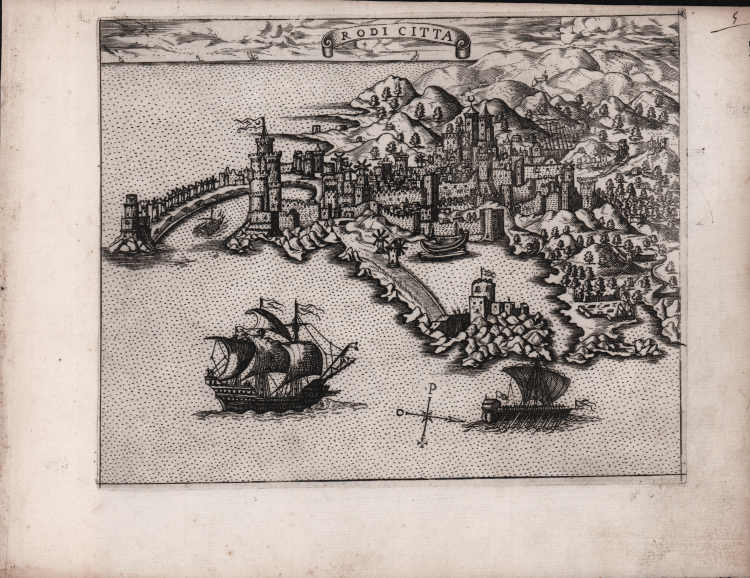



| Reference: | 4238 |
| Author | Giovanni Francesco CAMOCIO |
| Year: | 1566 ca. |
| Zone: | Rhodes |
| Printed: | Venice |
| Measures: | 200 x 160 mm |


| Reference: | 4238 |
| Author | Giovanni Francesco CAMOCIO |
| Year: | 1566 ca. |
| Zone: | Rhodes |
| Printed: | Venice |
| Measures: | 200 x 160 mm |
Rare first state before the number. From Camocio's "Isole Famose".
This work, as was usual for Camocio and his other contemporary publishers, was on the market as loose map and later included in the "Isole famose, porti, fortezze e terre marittime sottoposte alla Serenissima Signoria di Venetia, ed altri Principi Christiani, et al Signor Turco, nouamente poste in luce. In Venetia alla libreria del segno di San Marco".
The issue with the numbers are, instead, those inserted in the editions of the book published by Donato Bertelli - showing the imprint In Venetia alla libreria del segno di San Marco.
This edition, although without date, dates back to after 1575, the year in which the Camocio disappeared during the pestilence epidemic in Venice and much of its typography was acquired by Bertelli.
Etching with engraving, in good condition.
Bibliografia: S. Bifolco, Città e Fortezze Principali del Mondo, in Bifolco-Ronca "Cartografia e Topografia Italiana del XVI secolo. Catalogo ragionato delle opere a stampa" (2018), pp. 126, 140-141.
|
Gallo (1950): p. 98, n. 69 e p. 99, n. 28; Tolias (2011): n. 0406; Zacharakis (2016): n. 795a.
|
Giovanni Francesco CAMOCIO (Attivo a Venezia tra 1558 - 1575)
|
Publisher Venetian, born in the first half of the century. XVI, in an uncertain place, perhaps in Asolo (Treviso) perhaps Slot (Cream). Most likely the first hypothesis because the presence of Camocio family, originally from Piedmont, is widely documented in the town of Treviso. The family Camocio, also belonged the celebrated Hellenist John the Baptist, considered by some historians, relatives and even John's brother Francis. Camocio already resident in Venice, the Doge in 1552 asked for and obtained, together with other shareholders, as editor, the privilege for fifteen years to publish the translation into Latin of the writings of Greek authors. In his book publisher, is also attributed some ten editions in Health (until 1571). The main activity of Camocio, owner of the library "The symbolism of the Pyramid" in San Lio in Haberdashery, was the sale of prints and engravings, intaglio reproductions of important works of art and maps, while his activities as a publisher of books is fragmented and delayed in time. At the "Pyramid" is also sold books on spicy, like the sonnets printed by Domenico Zenoi, which earned him the payment of a fine: 10 ducats to the author and owner of 5 ducats a library. Camocio was one of the largest publishers of maps of the sixteenth century, all produced in a laboratory chalcographic definitely its own. Although it is very difficult to determine precisely how many cards you collected and managed to produce and print, because of the ease with which, over time, they falsified the names of authors, publishers, and dates were changed. However, the presence of his name in many papers and his demands for privilege testify to his busy schedule. Subjects taken by great artists such as Titian and Michelangelo, views of cities, fortresses and maps, for the realization of which were called to work as evidenced by the signatures on the cards, engravers and cartographers of the value of Domenico Zenoi (Zenoni), Donato and Ferdinand (Ferdinand) Bertelli, Paolo Furlani (Forlani) and Giacomo Gastaldi.
|
|
Gallo (1950): p. 98, n. 69 e p. 99, n. 28; Tolias (2011): n. 0406; Zacharakis (2016): n. 795a.
|
Giovanni Francesco CAMOCIO (Attivo a Venezia tra 1558 - 1575)
|
Publisher Venetian, born in the first half of the century. XVI, in an uncertain place, perhaps in Asolo (Treviso) perhaps Slot (Cream). Most likely the first hypothesis because the presence of Camocio family, originally from Piedmont, is widely documented in the town of Treviso. The family Camocio, also belonged the celebrated Hellenist John the Baptist, considered by some historians, relatives and even John's brother Francis. Camocio already resident in Venice, the Doge in 1552 asked for and obtained, together with other shareholders, as editor, the privilege for fifteen years to publish the translation into Latin of the writings of Greek authors. In his book publisher, is also attributed some ten editions in Health (until 1571). The main activity of Camocio, owner of the library "The symbolism of the Pyramid" in San Lio in Haberdashery, was the sale of prints and engravings, intaglio reproductions of important works of art and maps, while his activities as a publisher of books is fragmented and delayed in time. At the "Pyramid" is also sold books on spicy, like the sonnets printed by Domenico Zenoi, which earned him the payment of a fine: 10 ducats to the author and owner of 5 ducats a library. Camocio was one of the largest publishers of maps of the sixteenth century, all produced in a laboratory chalcographic definitely its own. Although it is very difficult to determine precisely how many cards you collected and managed to produce and print, because of the ease with which, over time, they falsified the names of authors, publishers, and dates were changed. However, the presence of his name in many papers and his demands for privilege testify to his busy schedule. Subjects taken by great artists such as Titian and Michelangelo, views of cities, fortresses and maps, for the realization of which were called to work as evidenced by the signatures on the cards, engravers and cartographers of the value of Domenico Zenoi (Zenoni), Donato and Ferdinand (Ferdinand) Bertelli, Paolo Furlani (Forlani) and Giacomo Gastaldi.
|